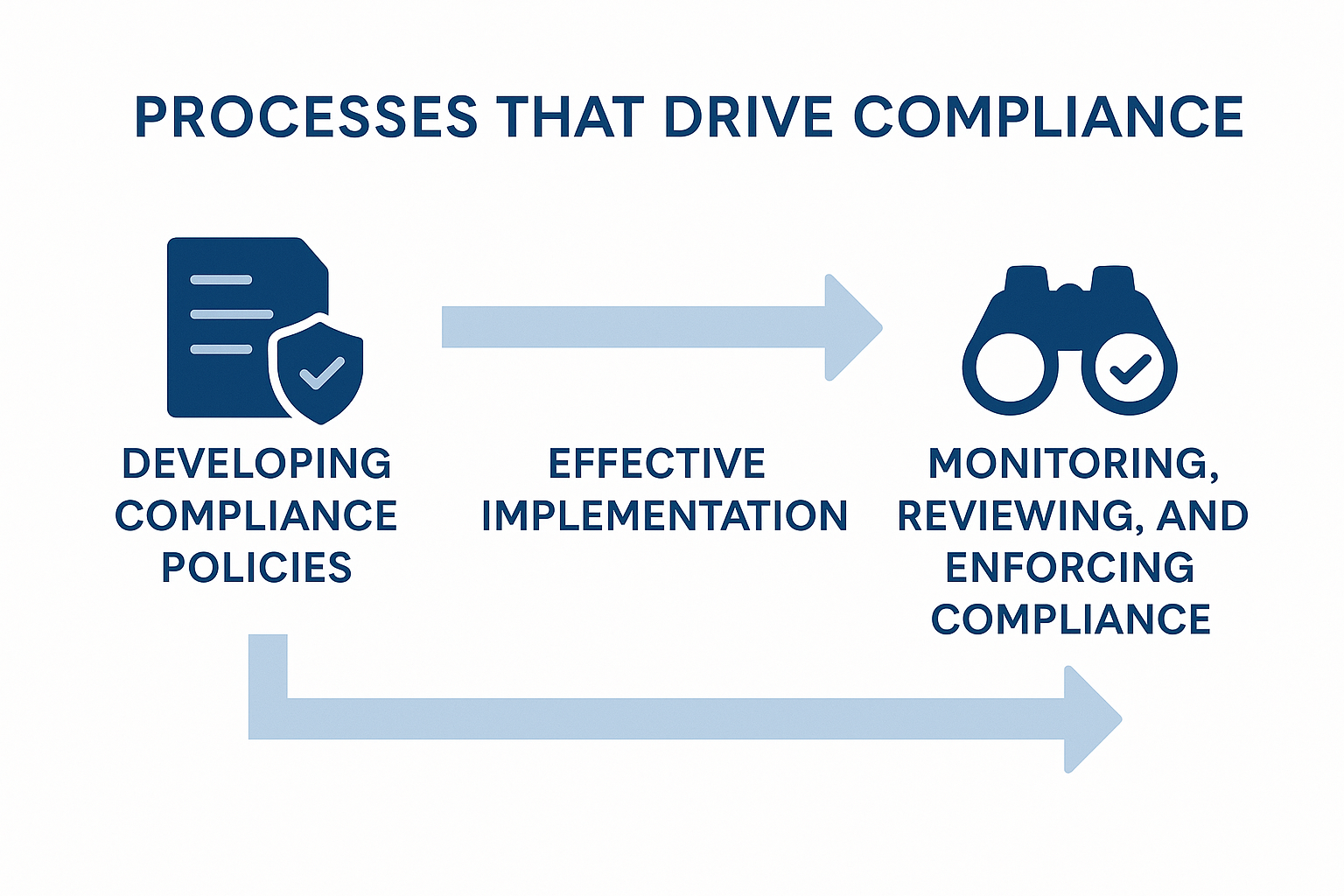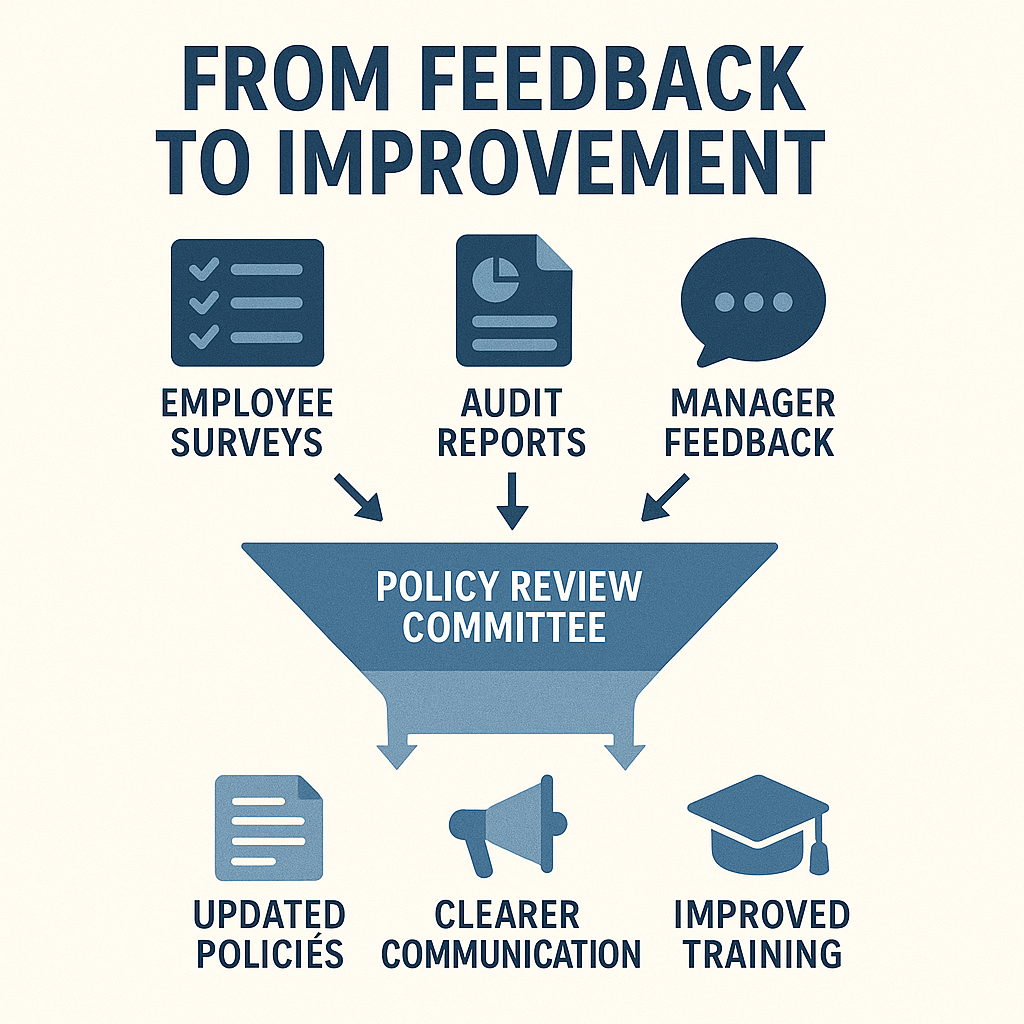“Rules are made to be broken” is a saying we’ve all heard at least once, right? It’s also one with which the majority of employers and HR directors would vehemently disagree. Rules at any company exist to minimize disruptions that negatively impact that company. An organization’s policies and procedures ensure your employees remain focused on their objectives. But without compliance, even the best-written, most comprehensive policies and procedures are all but useless. Learning how to ensure compliance with policies and procedures will help minimize these distractions while protecting the company.
Building a culture where employees understand the importance of compliance is integral to achieving this feat. A culture of compliance, much like Rome, cannot be built in one day or with one brick. However, having the right tools and knowing the proper steps will make building it much more straightforward.
In this article, we’ll discuss how effective compliance management strengthens business operations, and the ways you can make that a reality for your organization.
The Role of Policy Compliance in Business Operations
It’s easy enough to say that policy compliance plays a pivotal role in your business’s success – because it does. But what exactly does that mean? Let’s take a closer look at the different ways policy compliance impacts businesses.

Regulatory Protection
Compliance is a safeguard against legal trouble, not just a box to check! Having a policy in place without guaranteeing compliance will just indicate that you really should’ve known better or you or your employees are caught acting out of accordance with industry laws or regulations.
OSHA and HIPAA, for example, require documented proof of compliance. If you or your employees fail to demonstrate due diligence, your organization could face fines, legal action, or even loss of certification. Prioritizing compliance ensures that your policies actively protect your business.
Risk Management
Knowing how to ensure compliance with policies and procedures is also a crucial component of effective risk management. If an employee violates policies designed to identify or mitigate risk, your business must be able to prove that those policies were clearly communicated and understood.
Unmanaged risks can result in significant losses for an organization. Policies and procedures for risk management only serve their purpose when they are consistently followed. Compliance with these policies safeguards the company against unnecessary exposure..
Operational Consistency
Companywide policy compliance is key to maintaining cohesion across all facets of your organization. All rules and regulations should be followed and enforced uniformly, regardless of department or location. Noncompliance can lead to inefficiencies, miscommunication, and inconsistencies between departments. When your organization discovers how to ensure compliance with policies and procedures, it fosters a stable, predictable workflow that supports quality, reliability, and seamless collaboration.
Workplace Culture
Does your company facilitate a culture of accountability and responsibility? Whether or not your employees comply with workplace regulations serves as a good measurement of this. Employees who observe strong policy compliance reinforce the values of their employer, and help establish that thoughtful, professional conduct is one of those values. Consistent commitment to workplace regulations also promotes a transparent and fair environment in the workplace, boosting employee satisfaction and helping to reduce misconduct.
Reputational Protection
Noncompliance comes with the risk of possible financial or legal penalties, but it can also inflict lasting reputational damage. Customers and partners prefer to work with organizations that demonstrate a strong commitment to adherence with ethical and legal standards. A strong compliance record reinforces the integrity and reliability of your brand.
Conversely, compliance failures can spark public scandals, weaken trust, and drive clients and business partners away. The same way positive word of mouth can boost business, negative word of mouth can seriously erode an organization’s credibility. Prioritizing compliance is about avoiding penalties, sure, but it’s also about safeguarding your company’s reputation and securing its long-term success.
Processes That Drive Compliance
It’s called the policy lifecycle for a reason! Understanding how to ensure compliance with policies and procedures begins with those policies and procedures themselves. Specifically, it starts with creating, maintaining, and implementing policies for employee compliance. These policies should be clear and comprehensive, providing a strong framework for everyone within your organization to commit to their roles, and to maintaining a strong culture of overall regulatory compliance.

Developing Compliance Policies
Before anything actually gets written down, creating and managing compliance policies must begin with an in-depth understanding of the rules and regulations governing industry practices. Paying close attention to both legal and international laws that guide your industry will help you craft relevant, proactive policies.
Don’t treat this as a solo endeavor! It’ll be easier to know how to ensure compliance with policies and procedures if relevant stakeholders from across your organization are involved in the creation of policies governing that compliance. The policy development process should include team members from various departments and levels across the company. This will create a more multifaceted approach, helping to address all angles of potential regulatory impact.
Once you’re reached the stage of drafting and development, focus on making the policies you create clear, concise, and easy to interpret. Try to use precise, plain language, avoiding legal and technical terms to make policies as accessible as possible. You’re trying to create guidelines that are easily understood and applied by employees across your organization, not win a Pulitzer.
Effective Implementation
Wondering how to ensure compliance with policies and procedures? To start, don’t neglect the importance of the implementation stage. When you distribute completed compliance policies, strongly consider instituting comprehensive training programs to make sure employees have read these policies and understand them fully.
Ultimately, you set the tone for this part of the process. Leadership must demonstrate a commitment to these policies, and the tone you set as you do so will extend to the rest of your workforce.
Monitoring, Reviewing, and Enforcing Compliance
After distribution comes maintenance! Engage in continuous monitoring and regular audits as necessary to assess the effectiveness of compliance policies. Internal controls and periodic reviews will help identify instances of noncompliance and other potential risks.
Enforcing these policies is also a crucial step. After all, if an organization can’t take meaningful, consistent action when instances of noncompliance arise, your compliance policies won’t be worth the paper they’re printed on. Communicate to your employees what consequences they will face if they are noncompliant, and when necessary, follow through.
Best Practices for Ensuring Compliance
In the day-to-day operations of your workplace, here are some best practices for how to ensure compliance with policies and procedures.
Clear Communication
Before you can expect an employee to adhere to workplace rules, it’s a pretty good rule of thumb to tell them what those rules are. Effective communication is absolutely essential to pretty much every facet of a well-run workplace, and policy compliance is no different.
Help set expectations for employees regarding policy compliance by clearly communicating those policies. Once you have, ensure that policies and procedures are accessible to all employees in case they need clarification.

Avoiding Policy Stagnation
Effective policy management is an evolving, ongoing process that requires constant vigilance and adaptation. Do not succumb to inertia! Organizations need to regularly review policies and procedures. Nobody wants to conform to outmoded or ineffective rules. Use regular review cycles to stave off stagnation and to make sure policies stay current with relevant laws and regulations.

Compliance Auditing
Another way to assess effectiveness of your business’s compliance practices and policies is by conducting compliance audits. These audits gauge whether a company is successfully disseminating important policies to its workers, and whether employees read and acknowledged those policies. Compliance audits can also identify weaknesses such as outdated policies.
Get Feedback
Remember, communication is key! Effective compliance management requires active feedback. After policy distribution, consider using feedback mechanisms, such as surveys, to foster transparency and encourage continuous improvement.

Equal Enforcement
For a culture of compliance to grow, your employees must believe that the policies and procedures you’ve established are critical to the company’s success. Allowing exceptions, even for executives, devalues the importance of these rules and gives employees the impression that being non-compliant occasionally is acceptable. If deviations are allowed, non-compliance may become a problematic habit for employees to break.
Facilitating Compliance with Software
You might have noticed that exploring how to ensure compliance with policies and procedures can be…a lot. There’s a lot of steps, a lot of crucial stages and elements, not to mention a lot of employees who need to receive, understand and adhere to these regulations.
Consistency is crucial in policy management, yet manual compliance processes often lead to gaps in policy distribution. This can result in employees missing important updates or being entirely unaware of newly implemented regulations. Without a reliable system in place, ensuring that every team member has timely access to the latest policies becomes a challenge. Policy compliance management software eliminates these inconsistencies, ensuring that updates are communicated effectively and that employees always have access to current regulations.
Digital software management tools give teams a clearer vision of how to ensure compliance by streamlining compliance processes, freeing employees and management to spend more time and energy on the more complex aspects of their day-to-day jobs. Policy management software also centralizes and automates distribution with timestamps, creating an audit trail for accountability.
Digital solutions for how to ensure compliance with policies and procedures use real-time acknowledgement tracking, automated reminders, notifications, and quiz creation. They can also automatically flag problematic or missing responses. These features keep employees informed and in the loop, while allowing organizations to effectively verify their understanding of rules and regulations.
Make Your Policies Matter With ComplianceBridge
Creating policies is one step in policy management, but ensuring compliance is where the real challenge lies. Luckily, you don’t have to go it alone! ComplianceBridge and our automated policy compliance management software provides an end-to-end solution that streamlines everything from policy creation to distribution and beyond.
With automated workflows, you can seamlessly manage policy creation, revision, approval, and distribution, complete with built-in review dates, expiration dates, and reminders to ensure nothing falls through the cracks. Collaboration is easy, with multiple stakeholders able to refine policies in a single document. Once a policy is finalized, distribution is as simple as clicking a button. You can then track acknowledgment, test employee understanding with customizable quizzes, and analyze real-time compliance data with advanced metrics and reporting.
Effective policies must be accessible, which is why ComplianceBridge provides a centralized library for current policies and a lifetime archive for retired versions. This ensures that employees can always find the information they need when they need it.
If you’re wondering how to ensure compliance with policies and procedures, taking control of policy compliance is the first step. Contact us for a demo today and discover how ComplianceBridge can transform your business!